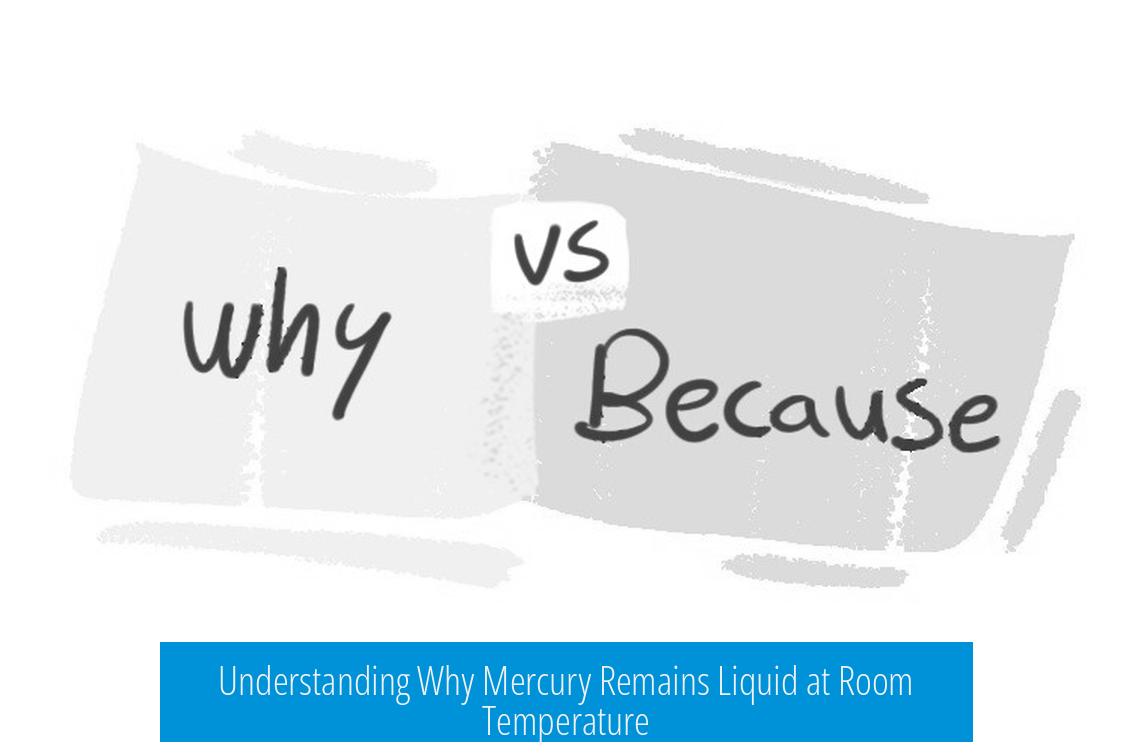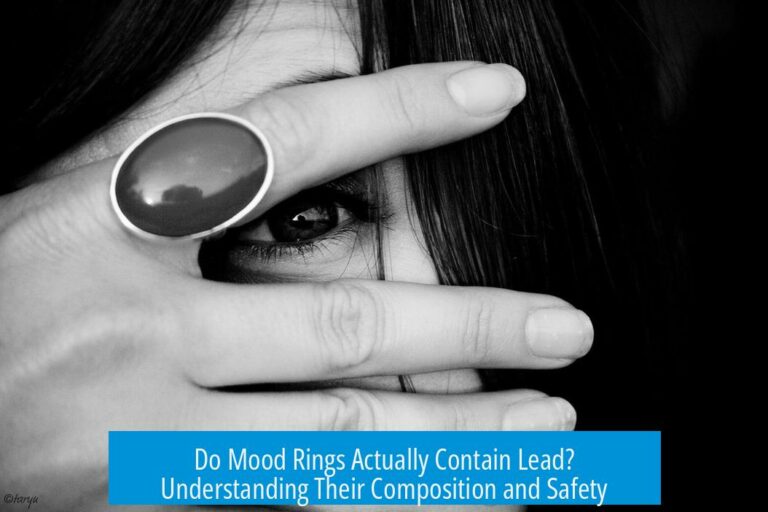Why Is Mercury Liquid at Room Temperature?

Mercury is liquid at room temperature primarily because its electron configuration and relativistic effects weaken its metallic bonds, resulting in a melting point below room temperature. This unique behavior arises from its filled electron subshells, a significant band gap, f-block contraction, and relativistic orbital contractions.
Electron Configuration and Weak Bonding

Mercury’s electron structure contains completely filled subshells. This stability makes it hard to remove electrons, unlike elements like zinc that lack a filled f shell. As a result, mercury atoms form weak metallic bonds.
Weak bonds mean less energy is needed to break them, so mercury has a low melting point. It melts at −38.83 °C, well below common room temperature (around 25 °C), explaining its liquid state under normal conditions.
Band Gap and F-Block Contraction

Mercury shows an unusual large band gap—energy difference between valence electrons and conduction states. This arises from f-block contraction, a phenomenon where filled inner f orbitals pull outer electrons closer, lowering their energy.
This band gap creates bonding that is partly metallic and partly non-metallic, unlike typical metals. Such atypical bonding weakens the metallic lattice and helps keep mercury liquid.
Relativistic Effects on Mercury
Heavy atoms like mercury experience relativistic effects. These effects contract electron orbitals further, especially the 6s valence electrons.
This contraction alters bond formation, reducing bond strength and lowering melting point even more. Relativistic quantum chemistry explains how these changes make mercury unique among metals.
Melting Point in Context
- Mercury’s melting point: −38.83 °C
- Room temperature: ~25 °C
- Other metals melt well above room temperature
Because mercury melts below room temperature, it remains liquid under normal environmental conditions, unlike most metals.
Key Takeaways
- Filled electron subshells resist electron removal, weakening metallic bonds.
- F-block contraction causes a large band gap, leading to unusual bonding.
- Relativistic effects further contract orbitals and reduce bond strengths.
- Mercury’s melting point is below room temperature, explaining its liquid state.
Why Is Mercury Liquid at Room Temperature? A Dive Into the Curious Case of the Silver Drop
Simply put, mercury is liquid at room temperature because its unique electron configuration and relativistic effects weaken its bonds, dropping its melting point below the usual room temperature. But that’s just the surface. Let’s unravel this mystery with a closer look at the atomic drama playing out inside mercury atoms.
If you’ve ever stared at a thermometer or a barometer and seen that shiny, silvery liquid sloshing around, you might have wondered why mercury behaves so differently from other metals. Most metals are solid at room temperature, right? So why does mercury gleam as a liquid? The answer is tucked away in quantum quirks and the peculiar behavior of electrons.
Electron Configuration: The Prime Suspect
Mercury’s key to liquidity starts with its electron setup. All its electron subshells are neatly filled—think of it as mercury’s wardrobe being perfectly buttoned up, no electrons out of place.
This already sets mercury apart from its cousins in the metal family, like zinc or cadmium, which have less filled electron shells. Because mercury’s subshells (including some pretty fancy f-orbitals) are entirely full, it stubbornly clings to its electrons. In chemistry lingo, mercury “resists removal of an electron,” which sounds like it’s playing hard to get.
- Filled subshells mean the metal’s atoms don’t share electrons as freely as other metals, leading to weaker metallic bonds between atoms.
Now, weaker bonds? That’s a melting point killer. When atoms don’t hold hands tightly, it doesn’t take much heat to pry them apart into a liquid state.
The Band Gap—Mercury’s Secret Bridge
The story gets spicier when we apply what scientists call the molecular orbital theory. Usually, in metals, there’s a small energy gap between the electrons in their valence (outer) shell and the conducting bonds that hold the solid together. But mercury walks its own path with a big energy hoop to jump through. This “band gap” is unusually large.
This means mercury doesn’t form purely metallic bonds like its lighter relatives. Instead, it occupies a twilight zone—part metallic, part non-metallic bonding. This unusual bonding style doesn’t build a robust lattice, so less heat is needed to liquefy the metal.
- This leads to a notable anomaly called the f-block contraction. This contraction basically shrinks mercury’s orbitals, lowering their energy and messing with bonding.
Relativistic Effects: When Einstein Joins Chemistry
Here’s where roller-coaster physics takes a seat. Relativistic effects, usually reserved for the high-speed racehorses like electrons orbiting heavy atoms, come into play.
Because mercury’s nucleus is hefty, electrons closer in feel the tug of Einstein’s special relativity. Their mass effectively increases, causing them to zip closer to the nucleus and contract their orbits. This orbital slimming impacts how electrons can participate in bonding.
These relativistic quantum chemistry effects further weaken mercury’s bonding by making its orbitals lower in energy and less available for sticking atoms together solidly.
In practical terms: Einstein is partially responsible for letting mercury sit around as a shiny liquid at room temperature rather than joining the solid metal club.
Anecdote Time: The Bus Ride Chemistry Class
Let’s lighten things up with a little story from university days. Picture two chemistry students chatting on a bus. Their intellectual banter about mercury’s electron quirks attracts a kindly old man.
He chimes in with a smile, “It’s liquid at room temperature because its melting point is below zero, you fools!” Simplicity can be poetic.
Yes, beyond atomic explanations, mercury physically melts at -38.83°C, so at around 20-25°C it’s comfortably liquid. No magic is needed, just facts about temperatures and the elements’ physical traits.
Putting It All Together: The Ultimate Mercury Liquidity Cheat Sheet
| Cause | Effect on Mercury |
|---|---|
| Filled Electron Subshells | Weak metallic bonds → low melting point → liquid at room temperature. |
| Large Band Gap (F-block Contraction) | Unusual bonding nature between metallic and non-metallic → weak atomic bonding. |
| Relativistic Effects | Orbital contraction → less bonding overlap → reduced melting temperature. |
| Physical Melting Point | Melting at -38.83°C → liquid in normal room conditions. |
Why Does This Matter? Practical Insights
Understanding why mercury is liquid at room temperature is more than curiosity. It’s vital for applications where mercury’s liquidity and metallic properties are unique.
- Mercury remains the only metal liquid at room temperature, making it perfect for thermometers, barometers, and some electrical switches.
- Its weak bonding also means it’s dense but can flow—the best of both worlds in a metal/liquid combo.
- Recognizing relativistic effects helps chemists design new materials and understand heavy elements better.
So next time you see a mercury thermometer, remember it’s not some magical liquid metal. It’s a very special element shaped by its electron dances and even Einstein’s rules.
Final Thought: Could There Be Other Liquid Metals at Room Temperature?
Mercury is currently the only metal liquid at room temperature. Gallium waits in the wings, melting just above room temperature around 29.76°C. Perhaps in a warming world, gallium might take the stage as a liquid metal too.
Until then, mercury remains the fascinating silver drop—a metallic liquid shaped by quantum quirks and relativistic twists.
Curious how other elements behave under these rules? It’s a world where physics meets chemistry and surprises await in every atom!





Leave a Comment